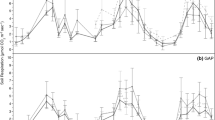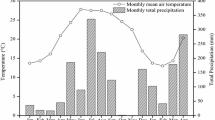Abstract
The effect of soil water content on efflux of CO2 from soils has been described by linear, logarithmic, quadratic, and parabolic functions of soil water expressed as matric potential, gravimetric and volumetric water content, water holding capacity, water-filled pore space, precipitation indices, and depth to water table. The effects of temperature and water content are often statistically confounded. The objectives of this study are: (1) to analyze seasonal variation in soil water content and soil respiration in the eastern Amazon Basin where seasonal temperature variation is minor; and (2) to examine differences in soil CO2 emissions among primary forests, secondary forests, active cattle pastures, and degraded cattle pastures. Rates of soil respiration decreased from wet to dry seasons in all land uses. Grasses in the active cattle pasture were productive in the wet season and senescent in the dry season, resulting in the largest seasonal amplitude of CO2 emissions, whereas deep-rooted forests maintained substantial soil respiration during the dry season. Annual emissions were 2.0, 1.8, 1.5, and 1.0 kg C m-2 yr-1 for primary forest, secondary forest, active pasture, and degraded pasture, respectively. Emissions of CO2 were correlated with the logarithm of matric potential and with the cube of volumetric water content, which are mechanistically appropriate functions for relating soil respiration at below-optimal water contents. The parameterization of these empirical functions was not consistent with those for a temperate forest. Relating rates of soil respiration to water and temperature measurements made at some arbitrarily chosen depth of the surface horizons is simplistic. Further progress in defining temperature and moisture functions may require measurements of temperature, water content and CO2 production for each soil horizon.
Similar content being viewed by others
References
Birch HF (1958) The effect of soil drying on humus decomposition and nitrogen availability. Plant and Soil 10: 9–31
Bottner P (1985) Response of microbial biomass to alternate moist and dry conditions in a soil incubated with 14 C-and 15N-labelled plant material. Soil Biol. Biochem. 17: 329–337
Carvalheiro K & Nepstad DC (1996) Deep soil heterogeneity and fine root distribution in forests and pastures of eastern Amazonia. Plant and Soil 182: 279–285
Clapperton C (1993) Quarternary Geology of South America. Elsevier Science, New York
Davidson EA, Belk E & Boone RD (1998) Soil water content and temperature as independent or confounded factors controlling soil respiration in a temperate mixed hardwood forest. Global Change Biol. 4: 217–227
Davidson EA, Stark JM & Firestone MK (1990) Microbial production and consumption of nitrate in an annual grassland. Ecology 71: 1968–1975
Davidson EA & Trumbore SE (1995) Gas diffusivity and production of CO2 in deep soils of the eastern Amazon. Tellus 47B: 550–565
Doran JW, Mielke IN & Power JF (1991) Microbial activity as regulated by soil water-filled pore space. In: Ecology of Soil Microorganisms in the Microhabital Environments (pp 94–99). Transactions of the 14th Int. Congress of Soil Sci. Symposim III-3
Ewel KC, Cropper WPJ & Gholz HL (1987) Soil CO2 evolution in Florida slash pine plantations. I. Changes through time. Canadian Journal of Forestry Research 17: 325–329
Hanson PJ, Wullschleger SD, Bohlman SA & Todd DE (1993) Seasonal and topographic patterns of forest floor CO2 efflux from an upland oak forest. Tree Physiology 13: 1–15
Howard DM & Howard PJA (1993) Relationships between CO2 evolution, moisture content and temperature for a range of soil types. Soil Biology and Biochemistry 25: 1537–1546
Jipp PH, Nepstad DC, Cassel DK & de Carvalho CR (1998) Deep soil moisture storage and transpiration in forests and pastures of seasonally-dry Amazonia. Climatic Change 39: 395–412
Kieft TL, Soroker E & Firestone MK (1987) Microbial biomass response to a rapid increase in water potential when dry soil is wetted. Soil Biology and Biochemistry 19: 119–126
Linn DM & Doran JW (1984) Effect of water-filled pore space on carbon dioxide and nitrous oxide production in tilled and nontilled soils. Soil Sci. Soc. Am. J. 48: 1267–1272
Lloyd J & Taylor JA (1994) On the temperature dependence of soil respiration. Functional Ecology 8: 315–323
Nepstad DC, de Carvalho CR, Davidson EA, Jipp PH, Lefebvre P, Negreiros GH, da Silva ED, Stone TA, Trumbore S & Vieira S (1994) The role of deep roots in the hydrological and carbon cycles of Amazonia forests and pastures. Nature 372: 666–669
Nepstad DC, Jipp PH, Moutinho PRS, Negreiros G & Vieira S (1995) Forest recovery following pasture abandonment in Amazonia: canopy seasonality, fire resistance and ants. In: Rapport DJ, Gaudet CL & Calow P (Eds) Evaluating and Monitoring the Health of Large-scale Ecosystems (pp 333–349). NATO ASI Series, Vol 128, Springer-Verlag, New York
Nepstad DC, Uhl C, Pereira CA & da Silva JMC (1996) A comparative study of tree establishment in abandoned pasture and mature forest of eastern Amazonia. Oikos 76: 25–39
Nepstad DC, Uhl C & Serrao EAS (1991) Recuperation of a degraded Amazonian landscape: forest recovery and agricultural restoration. Ambio 20: 248–255
Oberbauer SF, Gillespie CT, Cheng W, Gebauer R, Sala Serra A & Tenhunen JD (1992) Environmental effects on CO2 efflux from riparian tundra in the northern foothills of the Brooks Range, Alaska, U.S.A. Oecologia 92: 568–577
Orchard VA & Cook F (1983) Relationship between soil respiration and soil moisture. Soil Biology and Biochemistry 15: 447–453
Papendick RI & Campbell GS (1981) Theory and measurement of water potential. In: Parr JF, Gardner WR & Elliot LF (Eds) Water Potential Relations in Soil Microbiology (pp 1–22). Soil Science Society of America Special Publications Number 9, Madison, WI, U.S.A.
Raich JW & Nadelhoffer KJ (1989) Belowground carbon allocation in forest ecosystems: Global trends. Ecology 70: 1346–1354
Raich JW & Schlesinger WH (1992) The global carbon dioxide flux in soil respiration and its relationship to climate. Tellus 44: 81–99
Raich JW & Potter CS (1995) Global patterns of carbon dioxide emissions from soils. Global Biogeochemical Cycles 9: 23–36
Richter DD & Babbar LI (1991) Soil diversity in the tropics. Advances in Ecological Research 21: 315–389
Schlentner RE & Van Cleve K (1985) Relationships between CO2 evolution from soil, substrate temperature, and substrate moisture in four mature forest types in interior Alaska. Can. J. For. Res. 15: 97–106
Sombroek WG (1966) Amazon Soils, a Reconnaissance of the Soils of the Brazilian Amazon Region. PUDOC, Wageningen, Netherlands
Trumbore SE, Davidson EA, Camargo PB, Nepstad DC & Martinelli LA (1995) Below ground cycling of carbon in forests and pastures of eastern Amazonia. Global Biogeochemical Cycles 9: 515–528
Verchot LV, Davidson EA, Cattanio JH, Ackerman IL, Erickson HE & Keller M (1999) Land use change and biogeochemical controls of nitrogen oxide emissions from soils in eastern Amazonia. Global Biogeochemical Cycles 13: 31–46
Wildung RE, Garland TR & Buschbom RL (1975) The interdependent effects of soil temperature and water content on soil respiration rate and plant root decomposition in arid grassland soils. Soil Biol. Biochem. 7: 373–378
Author information
Authors and Affiliations
Rights and permissions
About this article
Cite this article
Davidson, E.A., Verchot, L.V., Cattânio, J.H. et al. Effects of soil water content on soil respiration in forests and cattle pastures of eastern Amazonia. Biogeochemistry 48, 53–69 (2000). https://doi.org/10.1023/A:1006204113917
Issue Date:
DOI: https://doi.org/10.1023/A:1006204113917




